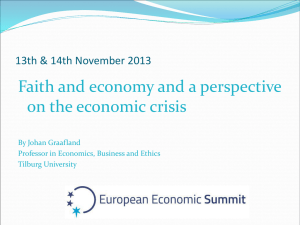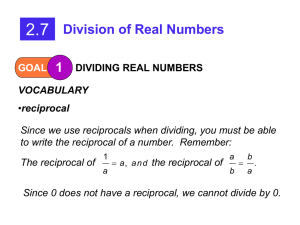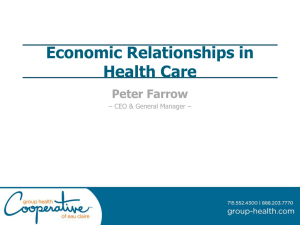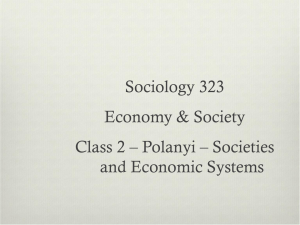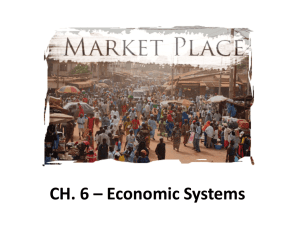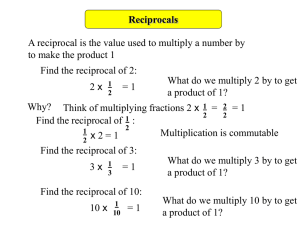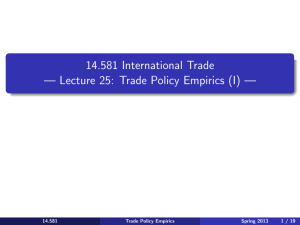Context and main concepts - Christophe Heintz
advertisement
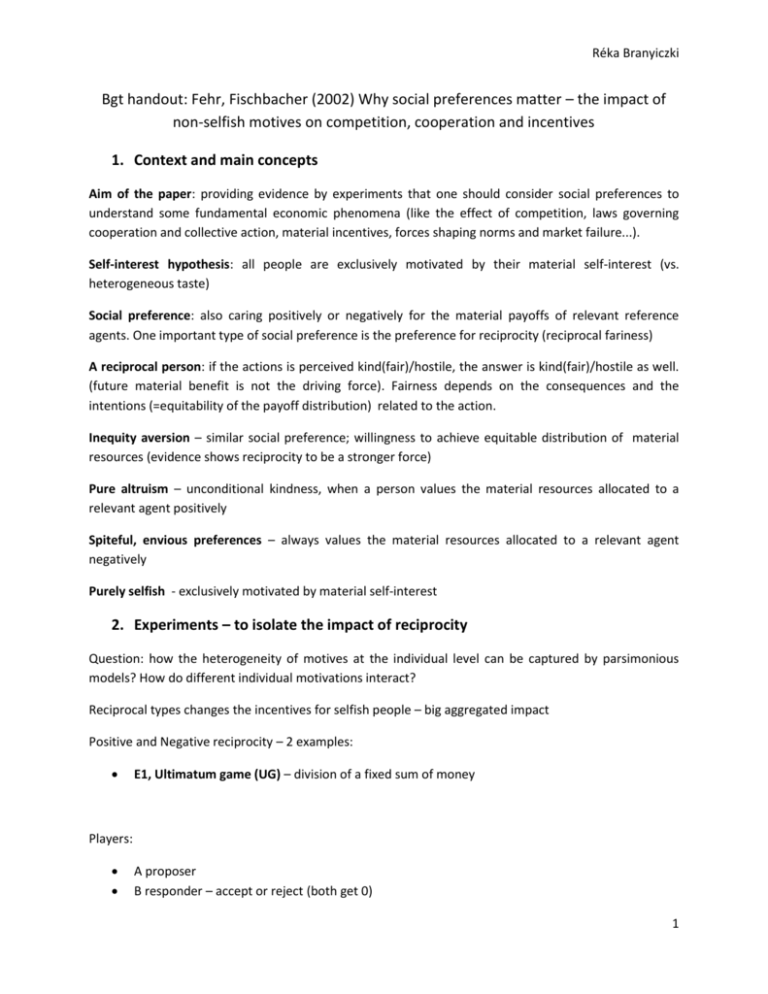
Réka Branyiczki Bgt handout: Fehr, Fischbacher (2002) Why social preferences matter – the impact of non-selfish motives on competition, cooperation and incentives 1. Context and main concepts Aim of the paper: providing evidence by experiments that one should consider social preferences to understand some fundamental economic phenomena (like the effect of competition, laws governing cooperation and collective action, material incentives, forces shaping norms and market failure...). Self-interest hypothesis: all people are exclusively motivated by their material self-interest (vs. heterogeneous taste) Social preference: also caring positively or negatively for the material payoffs of relevant reference agents. One important type of social preference is the preference for reciprocity (reciprocal fariness) A reciprocal person: if the actions is perceived kind(fair)/hostile, the answer is kind(fair)/hostile as well. (future material benefit is not the driving force). Fairness depends on the consequences and the intentions (=equitability of the payoff distribution) related to the action. Inequity aversion – similar social preference; willingness to achieve equitable distribution of material resources (evidence shows reciprocity to be a stronger force) Pure altruism – unconditional kindness, when a person values the material resources allocated to a relevant agent positively Spiteful, envious preferences – always values the material resources allocated to a relevant agent negatively Purely selfish - exclusively motivated by material self-interest 2. Experiments – to isolate the impact of reciprocity Question: how the heterogeneity of motives at the individual level can be captured by parsimonious models? How do different individual motivations interact? Reciprocal types changes the incentives for selfish people – big aggregated impact Positive and Negative reciprocity – 2 examples: E1, Ultimatum game (UG) – division of a fixed sum of money Players: A proposer B responder – accept or reject (both get 0) 1 Réka Branyiczki Under self-interest hypothesis: B should accept any positive amount Empirics: probability of rejection is decreasing in the size of the offer – punish unfair behavior; proposers anticipate rejection based on perceiving the action unfair (higher proposals on average than in a Dictator Game (DG), where B must accept the proposal). E2, Gift exchange game (GEG) – wage and effort exchange Players: A offers wage (w) B accepts w and chooses an effort level (e) or reject w (both get 0) Under self-interest hypothesis: B chooses lowest effort level and never rejects the wage offered Empirics: willingness to reward generous, fair actions. (principal agent relation) – strong positive correlation btw mean effort and offered wage UG, GEG - Considerable variation of responses, but approx 40-50% acts reciprocally (substantial fraction is selfish or random); regularities robust to stake levels 2.1. Concern: One-shot and repeated interactions - Inability to adjust properly to the one-shot interaction? In repeated interactions rewarding or punishing may be in the long term self-interest of an individual – are people able to adjust properly to one-shot interactions or the deviation from self-interest is only a rule-of-the-thumb behavior? GEG with baseline condition or reputation condition (proposer knew the history of answers of B) Empirics: higher acceptance threshold in the reputation condition 3. The impact of reciprocity in certain economic phenomena 3.1. Competition Exogenous contract enforcement: E3, UG with more (2, 5) competing responders (as a market transaction btw a seller and 2, 5 buyers) (Same game for 20 periods to control for learning effects) Under self-interest hypothesis: no effect on the power of the proposer, increasing competition does not affect the share the responders get 2 Réka Branyiczki Empirics: responders’ share decreases when competition increases as the rejection probability declines when there are more competing responders (the proposer cannot be punished if any of the responders accept the offer) Endogenous contract enforcement: E4, Double auction experiments 2 treatment conditions: bilateral condition without competition (=10 shot GEG game) and competitive condition Competitive double auction of 10 periods, 8 firms and 12 workers, cost of the worker: 20 Under self-interest hypothesis: competitive wage level is 20 due to excess supply of labor and workers provide minimum effort Empirics: wages are higher than predicted; competition has no long run impact on wage formation Implications: As contracts are enforceable, reciprocal individuals may nullify the impact of competition on market outcomes, because workers can set the quality of the good traded (effort) without exogenous enforcement involuntary unemployment; reason for insiders’ protection from outside competition; non-competitive wage differentials (effort choice is informed by the firm’s profit level) 3.2. Cooperation Free-riding: cannot be excluded from the benefits of the collective action, public good Q: Interaction between selfish and reciprocal types and how these interactions are shaped by the institutional environment? Conditional cooperation: E5, Prisoner’s dilemma (PD) Players: A: keep 10 or send 30 B: keep 10 or send 30 PD A keeps A sends B keeps 10; 10 0; 10 B sends 10; 0 30; 30 Under self-interest hypothesis : both of them keep the money Empirics: even in one-shot PD 40-60% cooperation rate 3 Réka Branyiczki Explanation: If we consider reciprocal people – PD becomes a coordination game with 2 pure strategy equilibria (both cooperate or both defect) 4-person public good games: 50% increase contributions to the public good if others’ average contribution is higher Simultaneous vs sequential PD -- reciprocal player induces the selfish player to cooperate Belief dependent cooperation as a social interaction effect (implications to social policy) 3.3. Cooperation and punishment N-person social dilemmas- how to prevent the decay of cooperation by the selfish types (even if they are minority)? –peer pressure, punishment (and threat of it) Strategic vs non-strategic punishment – cooperation-enhancing punishment of free-riders helps the enforcement of social norms is the punishment strategically motivated (future material benefit) or it is motivated by the desire to punish? Lack of evidence in favor of strategic sanctions Public goods experiment with punishment opportunity - in partner condition (sanction effects the material benefit) and in stranger condition – bulk of the sanctions appear in both cases 3.4. Material incentives and property rights Material incentives may be harmful: Modified GEG: desired effort level (not binding) or explicit performance incentive (fine if shirking is verified) Empirics: lower average effort in the case of explicit performance incentive Explanation: performance incentives that are perceived hostile cause hostile responses (less effort) Reciprocity-based vs explicit incentives Explicit contract (=performance contract plus the costs of verification are considered) or implicit contract Proposal (explicit or implicit contract) – choice – observing the effort - decision about the bonus, fine Under self-interest hypothesis: principal pays no bonus, worker provides only minimum effort Empirics: implicit contracts are more profitable because they induced higher effort level 3.5. Individual vs joint ownership Game with players A and B, where A can decide to be the sole owner of the firm and offer B wage or have a joint ownership with B 4 Réka Branyiczki Payoffs: A: v (a, b) – w – a if sole owner; 0,5*v(a,b) – a if joint ownership B: w-b if employee; 0,5*v(a,b) – b if joint ownership, where V (a, b): joint surplus conditional on the investments by A (a) and B (b) w: wage of B if being an employee (A is the sole owner) Self-interest model: a=b=1; A ownership is better Empirics: 80% A chooses joint ownership B has higher average investment level (8,9), A responds (a=6,5 on average) – joint surplus is higher under joint ownership 4. The modeling of reciprocity In addition to the selfish types, approx 40-50% of the people exhibit reciprocal preferences Challenge: explicit modeling of reciprocity results in very complex and difficult models 1st best solution so far: capture the behavioral predictions of reciprocity by simpler models of fairness (model based on the assumption that fair types dislike inequitable distribution of material resources – predictions are correct) 5. Concluding remarks Evidence indicates that preferences for fairness and reciprocity play an important role in bilateral negotiations, in the functioning of markets and incentives, in the structure of property rights, in the laws regulating collective action and cooperation. People do care for the well-being of others! Experiments may help to open the Pandora box of changing preferences 6. Discussion questions 1) Is there anything the authors missed to control for, which could be an explanation of the reciprocal behavior? 2) Why do we care if the game is simultaneous, one shot or sequential? 3) How would you create such legal regulations and social safety net that protect socially vulnerable people, i.e. homeless people the most efficiently? 4) What do you think which is more robust in enhancing cooperation (reciprocal behavior): the type of the person or the framing of the situation (institutions)? 5) Do you have any other economic phenomena in mind in which reciprocity plays an important role? 5


